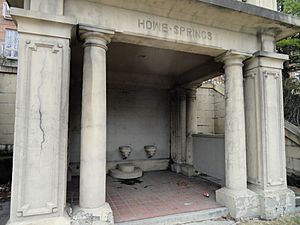Howe Springs facts for kids
 |
|
| Location | South Side of Fifth Ave. between S. Highland Ave. & College St (Shadyside (Pittsburgh)), Pittsburgh, Pennsylvania, USA |
|---|---|
| Coordinates | 40°27′6.21″N 79°55′27.04″W / 40.4517250°N 79.9241778°W |
| Area | Shadyside |
| Built/founded | 1896 and 1912 |
| Architect | 1896 - Alden & Harlow 1912 - W. H. Van Tine |
| Governing body/ |
Arnheim & Neely, Inc. |
Howe Springs is a special water fountain located in the Shadyside neighborhood of Pittsburgh, Pennsylvania. You can find it on the south side of Fifth Avenue, between S. Highland Avenue and College Street. This unique spring was first built in 1896. It had a style called Romanesque, which looks a bit like old Roman buildings. Later, in 1912, it was updated to a Neoclassical style, which is inspired by ancient Greek and Roman designs.
Contents
History of Howe Springs
No one knows exactly when people first started using the natural spring water at this spot. Reports from 1896, when the spring was first built, say that Native Americans once lived where Howe Springs now stands.
Who Was Thomas Howe?
The story of Howe Springs really begins with Thomas Marshall Howe. He and his family moved from Ohio to Pennsylvania and bought the land, calling it the Greystone Estate. Thomas Howe was a very important person in Pittsburgh. He worked in finance and politics, and he also did a lot of good deeds for the community.
Howe served two terms in the U.S. House of Representatives, representing Pittsburgh. He was first a member of the Whig Party. Later, in 1858, he helped start the Republican Party. During the Civil War, he was a high-ranking officer for Western Pennsylvania. He even turned down offers from two presidents, President Grant and President Hayes, to be a cabinet member.
Why Was the Spring Built?
The Howe family was inspired to create Howe Springs after the terrible Johnstown Flood in 1889. They wanted to make sure that clean, free water was available to everyone.
The first structure around the spring was built in 1896. It was designed by the architectural firm Alden & Harlow. This building was a memorial to Thomas Howe, built by his wife, Mary A. Howe, after he passed away.
New Owners and New Design
After Mary Howe died, her family sold the Greystone Estate, including the spring, to Michael Benedum in 1910. Michael Benedum was a rich businessman who made his money in oil and natural gas. He was also a philanthropist, meaning he gave a lot of money to good causes in Pittsburgh. The sale included a promise that the spring would always stay free and open to the public.
Soon after, in 1911, the city found that the water in Howe Springs was not clean. City workers had to destroy the old structure. Howe's family, who wanted to keep the spring free, took legal action. To solve the problem, a new plan was made for the spring. Architect W.H. Van Tine designed a new structure and a new way to get cleaner water. The new Howe Springs, with its Neoclassical design, opened again to the public in 1912.
In 2016, Howe Springs was nominated to become a City Historic Landmark by Preservation Pittsburgh.
Architecture of Howe Springs
The first building around Howe Springs was designed by Alden & Harlow. This firm worked mostly in Boston and Pittsburgh. Their design, built in 1896, was in the Romanesque Revival style. This structure lasted until 1910.
The second, and current, building was designed by William H. Van Tine, a well-known Pittsburgh architect. His design was in the Neoclassical style and was finished in 1912. This structure has strong influences from ancient Greece. Some people have even compared it to a new home for the ancient Greek Oracle at Delphi.
Gallery




